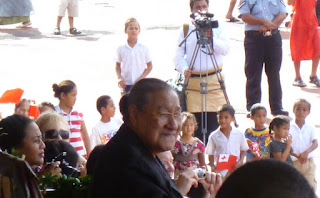Last Friday Tonga celebrated the Queen's 85th birthday. The public highlight was a gathering of most of the school children on Tongatapu at the big stadium here for a morning of singing and dancing.
Her Majesty Queen Halaevalu Mata'aho is the mother of King George Tupou V, Tonga's current King since 2006. He succeeded his father, the Queen's husband, King George Tupou IV who had been king for almost 40 years. She is well loved by her people as demonstrated by the tremendous outpouring of love we witnessed that morning.
Everybody sang happy birthday as six bands played.
For a great description of the day and other events of the weekend, please visit Elena and Mark's blog here: MK Squared
Video clips of the dancing are here:
Video clips of the dancing are here:
Herewith some background on the dances. (Thank you to the Tonga Visitors Bureau website for the descriptions of the dances.)
The Ma’ulu’ulu was performed by the Tonga Teacher's Institute and was led by Princess Frederika, the King's niece.
“The ma’ulu’ulu is a traditional Tongan dance, performed by a group of seated men and women; the dance form is a direct successor of the ancient Tongan ‘otuhaka. Performers sit down in a row on the ground with the right leg crossed over the left. If possible men and women alternate. On informal occasions the dance master may walk around, clapping his hands to keep up the rhythm and to encourage the performers. “
“For large performances of several hundred participants, dancers are placed in staggered rows. The most talented dancers and those of high social status are placed in the front row on the ground. Other rows are organised behind on benches of various height until the final standing row at the back.”
“Like the ‘otuhaka, the ma’ulu’ulu consists usually of alternating singing and instrumental sections. The dance starts with the beating of the nafa, a huge drum covered with a leather skin which is a remarkable spectacle in itself.” “The second part conveys the poetry in song and movement. Like all other Tongan dances, the gestures have a strong relationship with the words. The lyrics of the song are usually written for the occasion. A ma’ulu’ulu takes around 15 minutes to complete but it may have taken the performers several months to learn the sequence.”
The Tau’olunga was performed by Queen Salote College, an all-girls Wesleyan high school.
“The tau’olunga is a solo dance although it is occasionally performed by groups of up to six dancers. This is the greatest hour for the performer, body glistening with coconut oil, hair flowing free and dressed in elaborate costume. Only the prettiest and most skilled girls perform this dance. The tau’olunga is always performed according to the words of the song, thus if one observes closely, one can see when the dancer is depicting a sunrise, flowers worn in the ear or a lover departing.”
“While the dance is being performed, a young man can act as a contrast to the soloist by mimicking her movements in an exaggerated and clownish way. The caricature is supposed to draw attention to the beauty and skills of the performer.”
“A tau’olunga girl is usually clothed in a wrap dress. The dress can be made from tapa with traditional designs or a mat of handwoven pandanus leaves. Some girls wear a piece of cloth covered with green leaves, fragrant flowers, shells or sometimes a grass skirt. The dress is strapless and reaches to the knees, leaving the dancer’s arms and legs bare. As long skirts are the traditional apparel for Tongan girls, this is an occasion for performers to show off their shapely legs. Around her waist the dancer wears a belt (sisi) usually made from leaves and flowers. Bracelets and anklets may be worn, ranging from simple bands of cloth or tapa to beautifully elaborate. Performers wear a black ribbon with a white cowrie shell around the neck and no girl dances without her shell. A little crown (tekiteki) of feathers or grass is worn to enhance head movements during the dance. Costumes made entirely of natural materials are the most valued but unfortunately synthetic and plastic are making inroads in modern costume design.”
The Kailao was performed by Tonga College, an all-boys high school. Several of my clips were taken toward the end of the dance, and you'll notice the elaborate costumes are beginning to disintegrate, a result of the very high level of movement required.
“Kailao is a dance of foreign origin from ‘Uvea – Wallis Island and is a standing dance usually performed by men only.”“The dancers, of which there can be any number, wear fanciful costumes and decorated hats. The men, bearing stylized clubs (pate kailao), dance in a fierce manner that emulates fighting. Unlike most Tongan dances, the kailao is performed without singing. Instead, the performance is set to the accompaniment of a slit drum or a tin box which sets the tempo. This dance allows Tongan men to display discipline, obedience and skill with their weapons.”
(Go here for more information about the Kingdom of Tonga: http://www.tongaholiday.com/)






